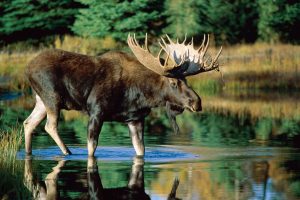Topics - Alaska
Alaska
Moose
 Native Alaskans have depended on moose for hundreds of years as sustenance, making it an important dietary staple. Approximately 7,000 moose are harvested annually in Alaska, amounting to about 3.5 million pounds of meat.1 Moose hunts involve many people from the village, and the meat is often shared with the community. Changes in climate and environment have impacted traditional ways of life, making subsistence hunting challenging. Hunting moose specifically has become harder, as traditional hunting locations are less predictable, due in part to climate-related changes in the environment. Moose populations have begun to decline as a result of disease, predation, and habitat scarcity.2 A continual decline will greatly impact the lives of Native Alaskans. As climate change continues to impact moose populations, Native Alaskans may begin to see smaller harvests and migration of other species, such as deer, northward..
Native Alaskans have depended on moose for hundreds of years as sustenance, making it an important dietary staple. Approximately 7,000 moose are harvested annually in Alaska, amounting to about 3.5 million pounds of meat.1 Moose hunts involve many people from the village, and the meat is often shared with the community. Changes in climate and environment have impacted traditional ways of life, making subsistence hunting challenging. Hunting moose specifically has become harder, as traditional hunting locations are less predictable, due in part to climate-related changes in the environment. Moose populations have begun to decline as a result of disease, predation, and habitat scarcity.2 A continual decline will greatly impact the lives of Native Alaskans. As climate change continues to impact moose populations, Native Alaskans may begin to see smaller harvests and migration of other species, such as deer, northward..
Sources:
- Alaska Department of Fish and Game. Moose (Alces alces). Available online from: https://www.adfg.alaska.gov/index.cfm?adfg=moose.printerfriendly [accessed January 20, 2023].
- Morse, S. April 2015. Declining Moose Populations: What Does the Future Hold? Northern Woodlands. Available online from: https://northernwoodlands.org/articles/article/moose-decline [accessed January 20, 2023].
CONNECT WITH US
Nikki Cooley
Co-Director
Nikki.Cooley@nau.edu
Karen Cozzetto
Manager
Karen.Cozzetto@nau.edu
Your tax deductible donation supports ITEP’s programming efforts.
Please contact us if you would like to contribute to our endowment or for any additional information regarding donations.

